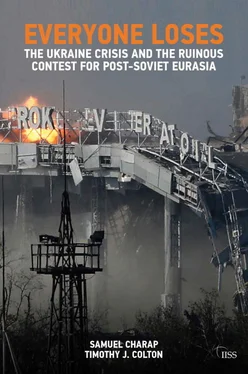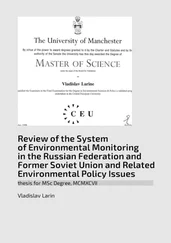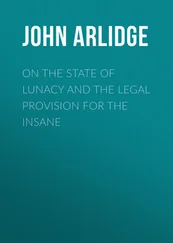What is often called Russian soft power in its neighbourhood became a focus in the period following the colour revolutions. But Joseph Nye’s classic definition of soft power – the ‘ability to get what you want through attraction rather than through coercion’ – never quite fit the Russian case. Less than two months after the Orange Revolution, Putin established a ‘department for inter-regional and cultural ties with foreign countries’ in the presidential administration, with a mission to solidify the bonds with former Soviet neighbours. Its first director was Modest Kolerov, the founder of the news site Regnum, which had a well-honed anti-Western bent and a focus on those same neighbours. Pro-Russian NGOs sprouted across the region, including in sensitive areas like Transnistria and Crimea. Groups of this ilk organised protests that disrupted a planned NATO–Ukraine exercise in the Crimean port of Feodosia in 2006. Assertions of Russian government funding for the NGOs throughout the region were ubiquitous in Western analysis. The evidence offered was circumstantial at best. A dearth of hard data is part of the problem: some groups certainly received financing from Russia, but the very opacity of these arrangements suggested a sinister intent, sharpening threat perceptions. Even though Moscow’s actions bore some likeness to common Western soft-power instruments, they lacked transparency and featured ominous undertones. It was more like ‘soft coercion’, as James Sherr puts it, than soft power. [17] James Sherr, Hard Diplomacy and Soft Coercion: Russia’s Influence Abroad (London: Chatham House, 2013).
Even efforts to engage Russian co-ethnics in the region seemed underhanded. [18] Marlene Laruelle, ‘The “Russian World”: Russia’s Soft Power and Geopolitical Imagination’, Center on Global Interests, May 2015; Sinikukka Saari, ‘Russia’s Post-Orange Revolution Strategies to Increase Its Influence in Former Soviet Republics: Public Diplomacy Po Russkii ’, Europe – Asia Studies , vol. 66, no. 1, January 2014, pp. 50–66.
The colour revolutions helped catalyse a tough Western, particularly American, approach to the region. In Washington, a well-placed faction within and around the Bush administration was determined to continue the enlargement of Euro-Atlantic institutions. Its most high-ranking member was then-vice president Dick Cheney, who, as he was to write in his memoir, ‘had long believed that the United States should play a more active role in integrating Ukraine and other former Soviet states into the West’. [19] Dick Cheney, In My Time: A Personal and Political Memoir (New York: Threshold Editions, 2012), p. 428.
It also included some figures who had been at the forefront of the first round of NATO enlargement. One of them, Ronald Asmus, explicitly argued in 2005 that:
the Orange Revolution has opened up an opportunity to redraw the map of Europe and Eurasia…. Anchoring Central and Eastern Europe to the West was a tremendous strategic accomplishment…. The Orange Revolution has now offered us the historic chance to extend that same degree of peace and stability further eastward into Ukraine, perhaps across the Black Sea and maybe eventually into Russia itself…. Ukraine’s anchoring to the West must become the next step in the completion of Europe and the Euro-Atlantic community.
He anticipated that Ukraine could be granted a NATO Membership Action Plan ‘no later than the next NATO summit in 2006’. [20] Ronald Asmus, ‘Redrawing (Again) the Map of Europe: A Strategy for Integrating Ukraine into the West’, in Joerg Forbrig and Robin Shepherd (eds), Ukraine after the Orange Revolution: Strengthening European and Transatlantic Commitments (Washington DC: The German Marshall Fund of the United States, 2005), p. 90.
For this group, expanding NATO’s writ had become intimately linked to democracy promotion. Bush himself writes in his memoir, ‘I viewed NATO expansion as a powerful tool to advance the freedom agenda.’ [21] George W. Bush, Decision Points (New York: Broadway Books, 2011), p. 430.
The period of largely unchallenged Russian predominance among the outside actors in the region had clearly come to an end. The fuse had thus been lit for an explosion. An ambitious agenda to seize the moment following the colour revolutions was taking hold in certain Western capitals. This agenda – and the conflation of nominal democratisation, as touted by geo-ideas, with geopolitical gain – was amplified by the new leaders in Kyiv and Tbilisi, who were far more savvy about getting their message across in the West than their predecessors. Incendiary rhetoric heightened Russian paranoia about Western intentions. In May 2006, Cheney delivered a speech in Vilnius, Lithuania, in which he said: ‘The system that has brought such great hope to the shores of the Baltic can bring the same hope to the far shores of the Black Sea, and beyond. What is true in Vilnius is also true in Tbilisi and Kiev, and true in Minsk, and true in Moscow.’ [22] ‘Cheney’s Speech in Lithuania’, 4 May 2006, http://www.nytimes.com/2006/05/04/world/europe/04cnd-cheney-text.html .
One can only conjecture the reaction to such statements in the Kremlin.
Yet there was no consensus in the West about extending offers of formal membership to the new aspirants in post-Soviet Eurasia. In NATO, one of the reasons cited by those member states opposed to such a step for Ukraine was the lack of popular support for membership. [23] In 2006, NATO membership was broadly unpopular among Ukrainians, including in the traditionally pro-Western central and western regions, where 23% supported and 29% opposed, to say nothing of the south and east, traditionally more pro-Russian (7% support for NATO, 77% opposed). Kyiv International Institute of Sociology data cited in Valeriy Khmel’ko, ‘Cherez shcho politykam vdayet’sya rozkolyuvaty Ukrayinu’, Dzerkalo tyzhnya , 23 June 2006, http://gazeta.dt.ua/ARCHIVE/cherez_scho_politikam_vdaetsya_rozkolyuvati_ukrayinu.html .
So the Bush administration pushed the Ukrainian authorities ‘to become more actively involved in the public outreach and education campaign about NATO and why it is in Ukraine’s national interest to join the Alliance’. [24] ‘Ukraine on the Road to NATO: A Status Report’, 14 February 2006, released by WikiLeaks as Cable 06KIEV604_a, https://wikileaks.org/plusd/cables/06KIEV604_a.html .
Washington was thus going far beyond support for Ukraine’s aspirations, as it often claimed. It was selectively reading those aspirations, focusing on parts of the elite and not the public, and attempting to alter them.
The Bush administration also threw more support than before behind the GUAM enterprise. It came in the form of high-level participation in US–GUAM meetings and a significant hike in financial support. [25] According to the US Department of State, at least US$2.5 million was spent on GUAM-related projects between the fiscal years 2004 and 2008. See US Government Assistance to and Cooperative Activities with Eurasia, http://www.state.gov/p/eur/rls/rpt/c10250.htm .
It is hard not to read US assistance to the grouping as anything other than an attempt to strengthen intra-regional ties that did not involve Russia.
The accumulated tensions began to take their toll on the regional security architecture. At the OSCE summit in Istanbul in November 1999, an Agreement on Adaptation of the Treaty on Conventional Armed Forces in Europe (A/CFE) had been signed, modernising the 1990 treaty as a confidence- and security-building measure for the post-Cold War environment. At the same summit, Moscow made commitments to withdraw its remaining military units in Georgia (in stages) and Moldova (by the end of 2002). Moscow ratified the new treaty, which it much preferred to the original, but slow-rolled the withdrawal commitments. NATO member states in 2002 adopted a policy of formally linking their ratification of A/CFE to Russia’s following through on its commitments. By 2003, the annual OSCE summits, the NATO–Russia Council (a consultative body established in 2002) and CFE implementation meetings were marred by polemics between Russia and the West about what came to be known as the Istanbul Commitments. The removal of troops from Moldova came to a halt in March 2004 and has never resumed. Russian forces had left Georgia by November 2007. [26] The Russian peacekeepers in Abkhazia and South Ossetia, stationed there under the terms of the ceasefire agreements that ended the conflicts of the early 1990s, were thus not covered by the Istanbul Commitments and remained.
By that time, though, the CFE regime at large was on the verge of implosion.
Читать дальше











